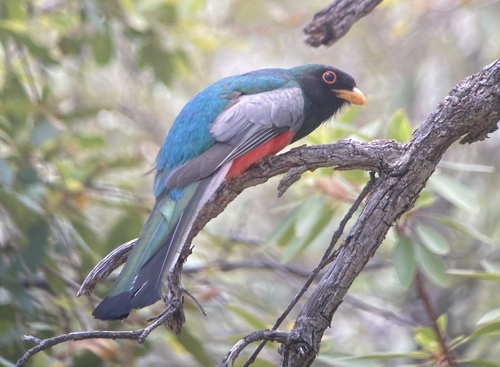
Elegant Trogon
The Elegant Trogon (*Trogon elegans*) is a strikingly beautiful bird renowned for its vibrant plumage and unique vocalizations. It plays a crucial role in its ecosystem as a seed disperser and insectivore, contributing to forest health and biodiversity. While not globally threatened, it faces localized habitat loss. The Elegant Trogon holds a place in some local cultures, often associated with beauty and the spirit of the forest. This species is a popular subject for birdwatchers and photographers due to its brilliant coloration.
28-30 cm
Length
38-41 cm
Wingspan
Least Concern
Conservation Status
Distribution
The Elegant Trogon's range extends from southeastern Arizona and southwestern New Mexico in the United States, south through Mexico to northwestern Costa Rica. They are generally non-migratory, but some populations may move altitudinally in response to food availability.
Lifespan
Unknown in the wild; likely 5-10 years based on similar species.
Elegant Trogon's Habitat
Habitat Types
Riparian woodlands, Canyon forests, Pine-oak forests, Tropical deciduous forests
Climate Zones
Subtropical, Temperate (at higher elevations)
Adaptations
Elegant Trogons have specialized feet with a heterodactyl toe arrangement (toes 1 and 2 point backward, 3 and 4 forward), which is unique to trogons and aids in perching on branches. They also have relatively weak legs, which are adapted to perching more than to walking on ground.
Variations
Several subspecies are recognized, differing slightly in plumage coloration and size. For example, *T. e. goldmani* in the Tres Marias Islands is known for its distinct barring.
Appearance
Breeding Plumage
Males have a brilliant metallic green head, back, and chest, with a bright red belly and undertail coverts. Females are duller, with a brownish-gray head and chest, and a paler red belly. Both sexes have white undertail barring.
Seasonal Feather Changes
Minimal seasonal variation, although plumage may be slightly brighter during the breeding season.
Sex Based Plumage Differences
Significant; males are much more brightly colored than females.
Notable Features
Bright red belly and undertail coverts (males), White undertail barring (both sexes), Metallic green upperparts (males), Brownish-gray upperparts (females), Yellow bill
Diet and Feeding
Primary Foods
Insects, Fruits, Small invertebrates
Foraging Behavior
Elegant Trogons typically perch quietly on branches, scanning for prey. They sally out to capture insects in mid-air or pluck fruit from trees. They are also known to hover briefly while gleaning insects from foliage.
Specializations
Their relatively broad, flat bill is well-suited for catching insects and handling fruit. Their heterodactyl toe arrangement helps in perching.
Seasonal Diet Variations
Diet may shift seasonally depending on the availability of insects and fruits. During the breeding season, they may consume more insects to provide protein for their young.
Behavior
Social Structure
Elegant Trogons are generally solitary or found in pairs, especially during the breeding season. They are not known to form large flocks.
Communication
A series of 'kow-kow-kow' calls, Whistles, Chattering sounds
Migration
Generally non-migratory, but some populations may exhibit altitudinal migration, moving to lower elevations in winter in response to food availability.
Territorial or Group Behaviors
Elegant Trogons are territorial during the breeding season, defending their nesting sites and surrounding areas from other trogons.
Conservation
Threats
Habitat loss due to deforestation, Habitat degradation from logging and agriculture
Protection Programs
Protected areas within their range (e.g., National Parks and Reserves), Some habitat restoration efforts
Local National Laws
Protected under the Migratory Bird Treaty Act in the United States.
Population Trend
Stable
Population Estimates
Global population estimated to be around 2,000,000 individuals.
Interesting Facts
Elegant Trogons are known for their 'kow-kow-kow' calls, which are often heard before the bird is seen.
These calls are used for communication, especially during the breeding season.
They have a unique heterodactyl toe arrangement.
This means that their first and second toes point backward, while the third and fourth toes point forward, which is unique to trogons and helps with perching.
Elegant Trogons are important seed dispersers.
By consuming fruits and later excreting the seeds, they help to maintain forest diversity.
Faqs about Elegant Trogon
What is the best way to see an Elegant Trogon?
Look for them in riparian woodlands and canyon forests within their range, especially during the early morning or late afternoon. Listen for their distinctive calls.
Are Elegant Trogons endangered?
No, they are currently classified as Least Concern by the IUCN, but habitat loss is a potential threat.
Do Elegant Trogons migrate?
They are generally non-migratory, but some populations may move to lower elevations in winter.
Copyright @ Nature Style Limited. All Rights Reserved.
 English
English